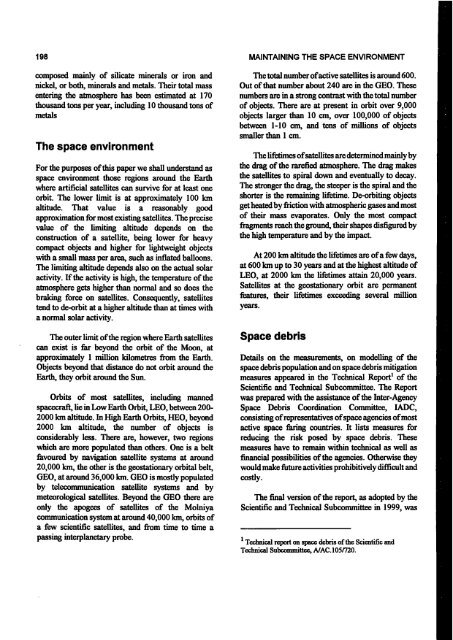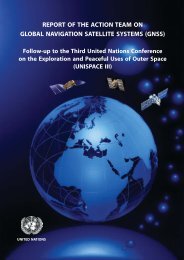Proceedings of the Workshop - United Nations Office for Outer ...
Proceedings of the Workshop - United Nations Office for Outer ...
Proceedings of the Workshop - United Nations Office for Outer ...
- No tags were found...
Create successful ePaper yourself
Turn your PDF publications into a flip-book with our unique Google optimized e-Paper software.
198 MAINTAINING THE SPACE ENVIRONMENTcomposed mainly <strong>of</strong> silicate minerals or iron andnickel, or both, minerals and metals. Their total massentering <strong>the</strong> atmosphere has been estimated at 170thousand tons per year, including 10 thousand tons <strong>of</strong>metalsThe space environmentFor <strong>the</strong> purposes <strong>of</strong> this paper we shall understand asspace environment those regions around <strong>the</strong> Earthwhere artificial satellites can survive <strong>for</strong> at least oneorbit. The lower limit is at approximately 100 kmaltitude. That value is a reasonably goodapproximation <strong>for</strong> most existing satellites. The precisevalue o f <strong>the</strong> limiting altitude depends on <strong>the</strong>construction o f a satellite, being lower <strong>for</strong> heavycompact objects and higher <strong>for</strong> lightweight objectswith a small mass per area, such as inflated balloons.The limiting altitude depends also on <strong>the</strong> actual solaractivity. If <strong>the</strong> activity is high, <strong>the</strong> temperature <strong>of</strong> <strong>the</strong>atmosphere gets higher than normal and so does <strong>the</strong>braking <strong>for</strong>ce on satellites. Consequently, satellitestend to de-orbit at a higher altitude than at times witha normal solar activity.The outer limit o f <strong>the</strong> region where Earth satellitescan exist is far beyond <strong>the</strong> orbit <strong>of</strong> <strong>the</strong> Moon, atapproximately 1 million kilometres from <strong>the</strong> Earth.Objects beyond that distance do not orbit around <strong>the</strong>Earth, <strong>the</strong>y orbit around <strong>the</strong> Sun.Orbits o f most satellites, including mannedspacecraft, lie in Low Earth Orbit, LEO, between 200-2000 km altitude. In High Earth Orbits, HEO, beyond2000 km altitude, <strong>the</strong> number <strong>of</strong> objects isconsiderably less. There are, however, two regionswhich are more populated than o<strong>the</strong>rs. One is a beltfavoured by navigation satellite systems at around20,000 km, <strong>the</strong> o<strong>the</strong>r is <strong>the</strong> geostationary orbital belt,GEO, at around 36,000 km. GEO is mostly populatedby telecommunication satellite systems and bymeteorological satellites. Beyond <strong>the</strong> GEO <strong>the</strong>re areonly <strong>the</strong> apogees <strong>of</strong> satellites <strong>of</strong> <strong>the</strong> Molniyacommunication system at around 40,000 km, orbits <strong>of</strong>a few scientific satellites, and from time to time apassing interplanetary probe.The total number o f active satellites is around 600.Out <strong>of</strong> that number about 240 are in <strong>the</strong> GEO. Thesenumbers are in a strong contrast with <strong>the</strong> total number<strong>of</strong> objects. There are at present in orbit over 9,000objects larger than 10 cm, over 100,000 o f objectsbetween 1-10 cm, and tens <strong>of</strong> millions o f objectssmaller than 1 cm.The lifetimes o f satellites are determined mainly by<strong>the</strong> drag o f <strong>the</strong> rarefied atmosphere. The drag makes<strong>the</strong> satellites to spiral down and eventually to decay.The stronger <strong>the</strong> drag, <strong>the</strong> steeper is <strong>the</strong> spiral and <strong>the</strong>shorter is <strong>the</strong> remaining lifetime. De-orbiting objectsget heated by friction with atmospheric gases and most<strong>of</strong> <strong>the</strong>ir mass evaporates. Only <strong>the</strong> most compactfragments reach <strong>the</strong> ground, <strong>the</strong>ir shapes disfigured by<strong>the</strong> high temperature and by <strong>the</strong> impact.At 200 km altitude <strong>the</strong> lifetimes are o f a few days,at 600 km up to 30 years and at <strong>the</strong> highest altitude <strong>of</strong>LEO, at 2000 km <strong>the</strong> lifetimes attain 20,000 years.Satellites at <strong>the</strong> geostationary orbit are permanentfeatures, <strong>the</strong>ir lifetimes exceeding several millionyears.Space debrisDetails on <strong>the</strong> measurements, on modelling <strong>of</strong> <strong>the</strong>space debris population and on space debris mitigationmeasures appeared in <strong>the</strong> Technical Report1 <strong>of</strong> <strong>the</strong>Scientific and Technical Subcommittee. The Reportwas prepared with <strong>the</strong> assistance o f <strong>the</strong> Inter-AgencySpace Debris Coordination Committee, IADC,consisting <strong>of</strong> representatives <strong>of</strong> space agencies <strong>of</strong> mostactive space faring countries. It lists measures <strong>for</strong>reducing <strong>the</strong> risk posed by space debris. Thesemeasures have to remain within technical as well asfinancial possibilities o f <strong>the</strong> agencies. O<strong>the</strong>rwise <strong>the</strong>ywould make future activities prohibitively difficult andcostly.The final version <strong>of</strong> <strong>the</strong> report, as adopted by <strong>the</strong>Scientific and Technical Subcommittee in 1999, was1 Technical report on space debris <strong>of</strong> <strong>the</strong> Scientific andTechnical Subcommittee, A/AC. 105/720.
















